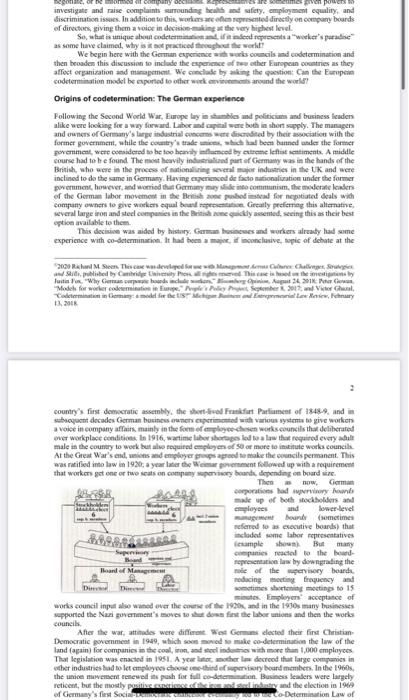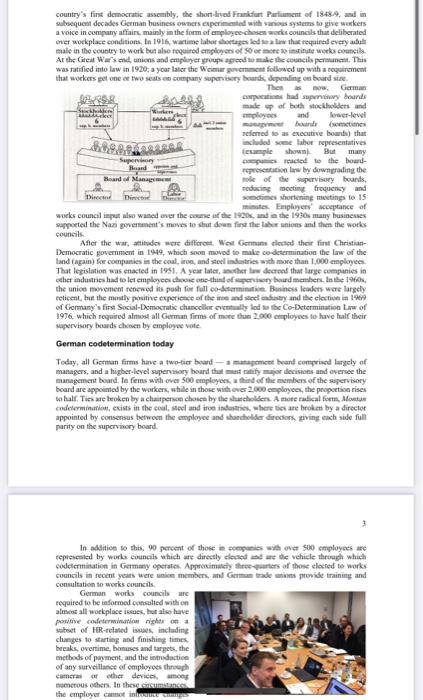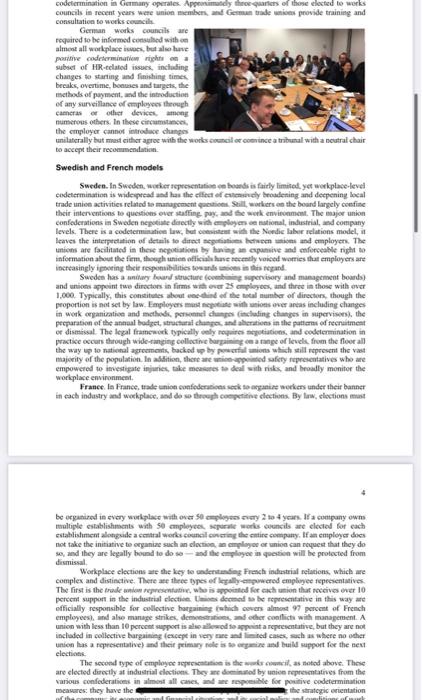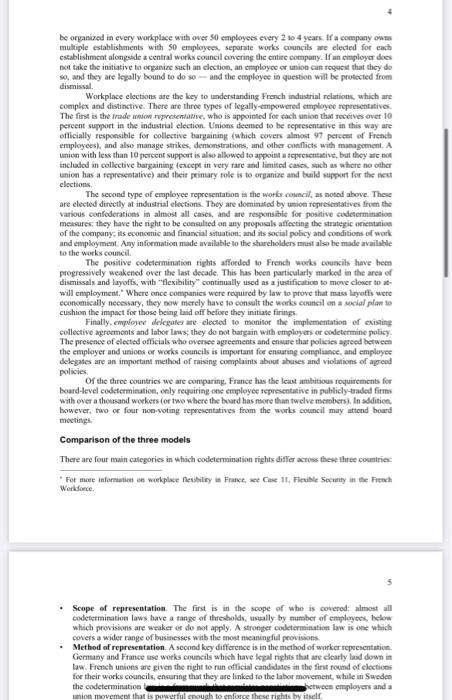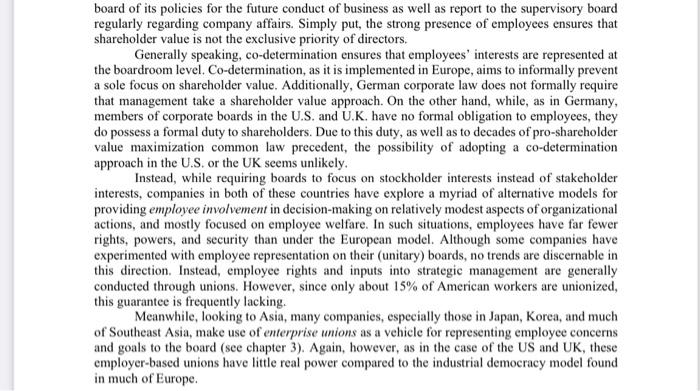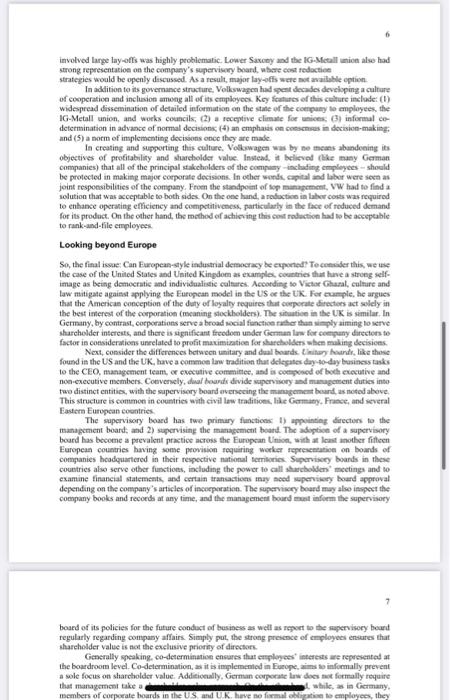1. In general, what are the benefits and limitations of co-determination systems as practiced in Europo (e.g., Germany, Sweden, and France)? What could other countries and companies around the world learn from these experiences? 3. How might co-determination influence the qualifications for successful managers in European enterprises? 9. As a senior manager, would you prefer to work in a company using a co-determination system or one in which managers have greater autonomy? investigate and raise complaints surroundng beuth and safety, employment equaliny, and ef dirvetios, giving them a voiee in decisise-muling at the very highest level. as some have claimel, why is is ab practiced thoog toat the werhf? We begin here with the Gerrman eyperitnee with wubs conscils ind codetamination and then beoden this disussion to indade the experimese of twe other Eunspein conatries as they affot organization and minapement. We canelale by alking the gostion: Can the Eurupein Origins of codeterminatien: The German experience Following the Second Woeld War, Europe ley in shumbles and politicium and business lenden alike were booking for a way forward. Laber and coped were bue in shon sepply. The maragen and vuners of Genmaty's lirge isfostrial eunerme wert diseroled by their asweiaticu with the former government, while the coentry's trade neves, shech hal bern bunnel asder the former inclined to do the same in Germany. Having experiassod de facto nationalization under the former eption availabie to them. This decivive was aided by hishary. Ganman hoincses and wurkers alraby had some experience with co-deteminarion. It had been a mepec, if iosoneluive, wpic of debate at the B. 3 ane countrys fist democratic assenbly, the thet-fivel frutifirt Parlinet of 1848, and in mal it the country to work but als tequited epplyen of so of more to intitute works councik. was reifsod imo law in 1920, a year later be Wienur penersment followed up with a requirenest that workers got one or two ieats on company wepervikery bount. dipending en bound wire. Then a now, Gimman eeppoations hat mprrining hownd male of of bech shelboldens atd enepioyes and borerdevel minagemear boundr (semetimes nefered to as exevinive boands) that incladed weme labor representatives (etample showa). But many ciepunies resesel to the beacdsepresentarica las by down nerating the male of the mervinery bourde. molucing mecting frequency and westimes sherinticg moctings to 15 risutes Eaployere aceeptatce of works council inper alwo waned over the couese of the 1920k ant in the 1930e many brasinesies wepported the Nax gavernenent's moves wo see dews fint the laber unions and then the works couneik. Affer the war, atthods were different. West Genmms elected their first ChriatianDemecratic poreniment in 1949 , which soen mand so make codeterminution the lww of the land (again) for sompanis in the coal, irom, and seol indertio with more than 1,000 employes. Titar legislation was enactod in 1951. A yeur lese, mecher len decrood that large componiss in the unioe muvelsent enewed as push for fall eo-deteminion. Buiness leaders were largdy country's fint democratic assembly, the short-lived Frunlfurt Partiument of 1848..9, asad in subeequent decades German business owners experimented with vaniss systens to give werkers a voice in company affairs, mainty in the form of employee chsen works councils that deliberated ever wockplace conditions, In 1916 , wactime labor dhertages led sea linw that requirstl every aluli male in the country to work but also required engoleyen of $0 er moee to imdinute werks councils. At the Cieat War's end, uniens and empleyer proupt agrend to make the councils peraunceit. This was ratified into law in 1920; a ycar later the Wcimar gowcmncat followed up with a requirement that workers get one er two seats en company superisisy beards, drponding en boand siac. Then as bow, Garman ampecatines had superitiory bounds made op of beth stockholder and anployecs and leaer-level mangovineet beadr (wenctitnes reforred is as executive boundvy that incladed scene labor representatives (cumple shown). But many enegpeise reacted to the bourFopreserticion lan by downerading the nole of the supervisory bounts, rodocing mocting froquency and semotimes shortening moctings to 15 woks counct inpat also wased over the canne of the 1930s, ant in the 1930 s many businesses seppeted the Naze goverment's moses to shit dewn fird the labir mions and then the works eouncils. After the war, atitides mere different. Wee Germans dlesed their firt ChriatianDemocratic povernment in 1949, which soon moved to make co-determination the law of the land (again) foe companies in the coul, irve, and steel indatries with more than 1.000 employers. That legislation was enacted in 1951. A year tater, another lis decrend that large companies in ceher induvtries had to let employees cheone one-thind of eperuepy bourd menaben. In ise 1940 . the uniod movemen rencwed its push for fall eo-denerminitive. Baniness leaders ware largely eeticent, bue the mondly positive experiene of the inee and weti makiby and lhe elective in 1907 of Germany's first Social-Democratic chanccllot cicmeally lod so the Co-Determination Law of 1976. which reguired alnwed all German firms of mine than 2,000 cmployees to have half their yegervisory bourds chesen by employes vote. German codetermination today Tedry, all German firms have a two-tier beard - a matupement beant congriacd largely of managers, and a higher-level supervisory bourd that matt ratify major decisions and eversee the management board. In feins with over 500 employees, a thitd of the members of the aupervisory board are appointed by the workers, while in those with ever 2,000 enployees, the peopertion rises codederminatiow, exists in the coal, seel and iroe isdantick. =here bis ate broken by a director appointed by consensus betwoen the mployee and shandbelder diresiors, giving each side full parity on the supervimory bourd. In adlitioe to this, 90 pereent of those in esempueiss with over 500 cmployes are reptesenitd by worke councels which are diresely elested asd ate the vehicle thrumgh which codetermitation in Germany eperates. Appreximitely illese-qurters of those eleceded to works councils in recent years were unicen members, abl German trade ativins prowide training and consultaticn to works councils. codctermination in Ginmany eperalcs Apponimady throe quanters of those elocted to werks councils in recent years were union member, and Germun tade whives provide training and consultatien to works cencilh German werks councils are required to be informed consulked with ien alment all workplace twees, but also have porinive codricminatien rights on a subset of HR-telated issucs, incluating changes to starting and finishing times beaks, overtime, boouses and turgets, the methods of puyment, and the introduction of any surveillanes of eaployes tieough caencras of othat devices, among numerous others, In these circamutases, the employer cannot introdese dhangs unilaterally but most eithsr agree with the works evencil or evenince a tribural with a neurral chair to accept their reconmendation. Swedish and French models codetermination is widepread and has the clleet of enemerely troudening and deepening beal trade unien astivities relatd to manugencnt quetions. Still, workers an the bound larpely ceefiac their interventions to questions ever staftine puy, and the work envibumeat. The major union confedcrations in Sweden nepotiate deectly with eployen ae nutionat, industrial, end company levels. There is a codeterminatien low, but eensigent with the Nondic labor relations model, it information about the fem, theoph whien officiali have fecently voised worries dist employers are increasingly ipeseing their reponibilities towarls anioes in tirs mgand. and unions appoint tue dirstors in firms with ever 25 ceployess, and three ia those with over proportion is not set by law. Enployers mast meptine with wions over antas including changes perpuration of the antal bucget, itracturaf changs, and alkerations in the pulters of fecruitmeef of dismisal. The legal framencok typieally vely requires Appetacions, and codetermination in Whatice accurs theveugh wide-tinging colloctine burgaining ee a nange of levels firm the floor all the way up to national agreements backod ip by powitfal anions which sill repeesent the vas majerity of the population. In adsition, there ane wnioesperined safery representatives who are woriplace envinonment. in each indastry and wokkplace, asd do so dreopl coepentine clectivas. By lrww, shections mast be ofgatired in every wurlplase with over 50 aployes evary 2 to 4 yein. If a coupuny own multiple establishments with 50 empleyes. seporate works suencils are elected for exch establishiment alotgs side a cmatal werkis council eovering the cmitire cempury. If an employst does not take the initiative to organiag such an eloction, an emplyo or union can request that they do se, and they are legally bound to do so - and the enployse in quedion will be protected from dismissal. Werkplace elections ats the key te undentmies french indutrial relutions, which are complex and distinctive. There ase thece types of lefally-enpuwered emplyee fepesentaives. Tbe firs is the erade antan representativ, whe is appeittod fir eich union that neceives ewer 10 pereern suppoft in the industrial rlectice. Vaiser deemed as be reprecentative in this way are officially responsible for collective haggaining fahich coven almont 97 percet of French union with less than 10 perocent shport is almo allewed to uppint a repecentative, but they are not incloded in collective hargaining (excepe in very mese and linined caves, such as where no odher elections. The secoed type of employes aesientition is the wedr soweit, as notad above. These are clectiod diecelly at induarial clections. They ane deetinuod by unien repretentetives from the various confederations in almont all canes, and are repeesible for poritive codetermination meavares: they have the be ofganized in every workplace with over 50 employees every 2 to 4 yeark. If a company owns multiple establishments with 50 employes, separate works councils are elected for each establishmeat alongede a central works coxincil covering the entire company. If an employsr dos not take the initiative to organine such an cloction, an cmployes or union can reyubet that they do so, and they are lezally bound to do so - and the employee in question will be protected from dismissal. Workplace elections are the key to understanding French industrial relations, which are complex and distinctive. There are three types of legally-empowered employee representative. The first is the irade indion represenlative, who is appointed for each union that receives over to percent suppoct in the indusirial election. Unioes deemed to be ecpessentative in this way are officially responsible for collective bargaining (which covers almost 97 perceat of French employess, and also manage strikes, demonstrations, and other conflicts with manugement. A union with less than 10 percent support is also allowed to appoist a tepecientative, but they ate not included in collective burgaining (ectept in very rart atdl limited casex, sach as where no other union has a fepresentative) and their primary fole is to organize and build suppont for the aedt elections. The second type of employee representabion is the works conmeil, as noted above. These are elected dirtetly at indastral elections. They are dominatod by union represertatives from the various confederations in almost all cases, and are responsibie for positive cedeterminanion measures: they have the right to be coasulied on any proposals aflecting the strategic onientanion of the company; its econoenic and financial situation: and its social policy and conditions of werk and employment. Any information made availbble to the shureholders mast also be made availahle to the works council. The positive codetermination rights afforded to French works couscils have been pregressively weakened over the last decade. This has been particularly marked in the area of dismissals and layoffs, with "flexibility" continually used as a justification to move clover to atwill employment." Where ence companies were required by law to prove that mas liyotfs were economically neeessary, they now merely have to consalt the werks ceuncil on a sociaf plan to cushion the impost for those being laid off befoee they initiate firings. Finally. emplovec deligutes are elected to monilor the implementation of existing collective agroements and labor laws; they do not bargain with employers or codcternine policy. The presence of eleeted officials who overse agreements and envure that policies agreed berween the employer and unions or works councils is iepportant for ensuring eotrplaase, and employee dekegates are an important method of raising coemplaints about abuses and violations of agreod policies. Of the three countries we are comparing. France has the leas ambitious requirements for buard-level codeterminatioe, enly requiring one enployee representative in publicly-traded firms with over a thousand woekers (or two where the beurd has nore thun twelve members). In additice. bowever, two or foar noo-voting representatives from the works council may attend board mextings: Comparison of the three models There are four main categories in which codetermination rights differ across these thres cosutrie: "For moer informatien on wekplace ferilitiry in France, see Case 11, Fieville Security in the Fithel Workfore. - Scope of representation. The first is in the scope of who is cotered; almost all codetermination laws have a range of thredholds, usually by number of empleyoes, below which provisions are weaker of do not apply. A stronger codeternination lew is one which covers a wider range of busineses with the enoet nieaningfil provisions. - Method of representation. A second key difference is in the method of worker repesentntion. Germany and France ase woeks councils which have lepell rights that ane clcarly laid down in law. French unions are given the right to run official candidanes in the firit round of elections for their works councils, ensuring that they are linked to the laber movement, while in Sueden the codetermination board of its policies for the future conduct of business as well as report to the supervisory board regularly regarding company affairs. Simply put, the strong presence of employees ensures that shareholder value is not the exclusive priority of directors. Generally speaking, co-determination ensures that employees' interests are represented at the boardroom level. Co-determination, as it is implemented in Europe, aims to informally prevent a sole focus on shareholder value. Additionally, German corporate law does not formally require that management take a shareholder value approach. On the other hand, while, as in Germany, members of corporate boards in the U.S. and U.K. have no formal obligation to employees, they do possess a formal duty to shareholders. Due to this duty, as well as to decades of pro-shareholder value maximization common law precedent, the possibility of adopting a co-determination approach in the U.S. or the UK seems unlikely. Instead, while requiring boards to focus on stockholder interests instead of stakeholder interests, companies in both of these countries have explore a myriad of alternative models for providing employee involvement in decision-making on relatively modest aspects of organizational actions, and mostly focused on employee welfare. In such situations, employees have far fewer rights, powers, and security than under the European model. Although some companies have experimented with employee representation on their (unitary) boards, no trends are discernable in this direction. Instead, employee rights and inputs into strategic management are generally conducted through unions. However, since only about 15% of American workers are unionized, this guarantee is frequently lacking. Meanwhile, looking to Asia, many companies, especially those in Japan, Korea, and much of Southeast Asia, make use of enterprise unions as a vehicle for representing employee concerns and goals to the board (see chapter 3). Again, however, as in the case of the US and UK, these employer-based unions have little real power compared to the industrial democracy model found in much of Europe. invelved large lay-ofts was haghly probiematic. Lower Saxony and the IG-Mcall inion alwe had itrong representation on the compuny's supervimxy boand, whare enat tedoctioe strategies would be openly discussed. As a result, major lay-offs were not avaible eption. In adlition to its governance structure. Velkswagea had pest decades developing a culture of cooperation and inclusion among all of its empioyees. Key features of this celhure inchude: ( 1 ) widespread dissemination of detailed information on the stane of the coerpury lo employess, the IG-Metall union, and works councils, (2) a receptive climate foe uniees, (3) informal cedefermination in advase of normal decisions, (4) an emphasas on coescnus in docision-making: and (5) a norm of imsplementing decisions once they are made. is creating and supporting this culture. Volkwagen was by ne thems abandening its objectives of protitability and sturcholder value. Insted. it belisved the many German companies) that all of the principal stakehnlders of the cimpuny -inchating employees - should be protected in making majer corporate decisions. In eher wonds. apital and laber were seca as joint responsibilities of the conipany. Froen the standpoent of kop management, VW had to find a solution that was acceptable to both sides. On the one hand, a reflectien in laber cosss was required to entance operaing efticiency and compctitiveness, particulatly in the fice of roduced demand for its product. On the other hand, the method of achicving this cost roluction had to be accepeable to rank-and-file employess. Looking beyond Eurepe So, the final issae: Can Furopeas-style industrial demacracy be exponed? Te consider this, we wie the case of the United States and United Kingdom as examples, countries that huve a strong selfimage as being democratic and individualistic culares. Acconding to Victor Ghazal, cultire and law mitigate agaiest applying the European model in the US oe the UK. For eunple, he argues that the American conception of the daty of loyalfy reguires that oueperate directors act sulely in the best imerest of the corporation (meaning siockbolders). The situative in the UX is similar. In Germany, by contrast, corporations serve a broad wocial functioe raller than winply aiming to serve sharcholder intereats, and there is significant freodom undar German law for ceefiny dirstons to factor in consideratiens unelated to profit maximizatice for shurcheldens when mikint decisices. Next, consider the differences betwech unitary and dat bourds. tinitury hounil, like those found in the US and the UK, have a commen law tradition thar delegates day-40-dvy basiness tanks to the CEO, mazagenent team, or evecutive committee, asd is conponed of bodh executive and noo-erecutive members. Conversely, dial boundx divide sppervisory asd musugenent duties into two distinct entitics, with the supervisery board aversecing the mamegensert beard, as notod above. This structure is comenon in coundries with civil law traditions, hie Germaty. Frase, and several Eastern Europtan coontriss. The supervisory boued has twe primury functions 1) uppointieg directum to the management board, and 2) supervising the management boart. The adoptive of a supervisory bourd has become a prevalent practice across the European Union, with at lewit another fitteen Europea coundies having some peovision sequiring werker representation on boands of companies headquartered in their respective national temitorics. Segervisery boands in these couetries also serve other functioss, including the power to call shurcbolden' meetings and to examine finaneial statements, and certain iransactices thay aced inperikery bourd appoval depending on the company's articles of incoeporation. The rupervikery beard may also inspect the company books and records at any time, and the management bourd mut inform the supervisocy board of its policies for the future conduct of besiness as well as repert to the mepervisery beurd regularly regarding company affairs. Simply put, the stroug presence of employess ensures that shareholder value is act the exelusive priority of directork. Generally speaking. co-desermination ensures that exploy ess' ietereats are reposented at the boardroom level. Co-determination, as it is implememed in Fueope, aims to informally perevent a wole focus on sharcholder value. Additionally, Germsin copporate law doss met formally require members of corperate boards in the US, and U.K. heve no firmal akhiratine to employees, they

